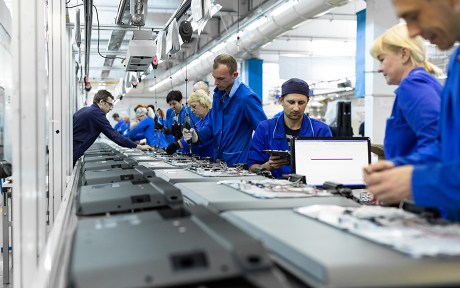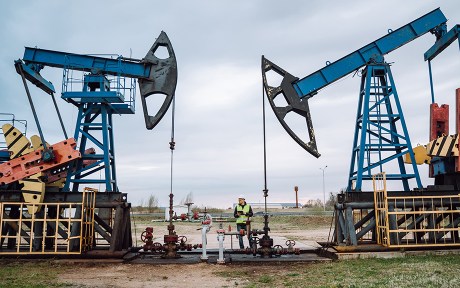
In a previous post, we provided evidence for a broad-based slowdown in productivity growth across industries and firms in the U.S. manufacturing sector starting in 2010. Since firms’ investment in research and development (R&D) for new technologies constitutes a central driver of productivity growth, in this post we ask if the observed slowdown in productivity may be due to a decline in R&D. We find that “R&D intensity” has been increasing at both the firm and industry level, even as productivity growth declines. This points to a decline in the effectiveness of R&D in generating productivity growth in U.S. manufacturing.
The Sources of Productivity Growth
We develop two measures of R&D intensity in U.S. manufacturing. The first measure is the ratio of R&D expenditure to gross output. The second measure is the ratio of real R&D expenditure per worker hour, which deflates R&D expenditure by the wages of skilled workers in the U.S. We use these measures in the aggregate data from the Bureau of Labor Statistics (BLS) and Bureau of Economic Analysis (BEA), and at the firm level by leveraging data on public firms from Compustat/CRSP. The chart below plots R&D intensity measures from the BEA/BLS from 1987-2022.
Rising Aggregate R&D Intensity in Manufacturing
Ratio (1987=100)
Ratio (1987=100)
Sources: Authors’ calculations based on the Bureau of Labor Statistics (BLS) Productivity Accounts and the Bureau of Economic Analysis (BEA) Private Non-Residential Investment Accounts.
Notes: The chart shows the reported R&D expenditure as a share of gross output (left panel) and deflated R&D expenditure per worker hour in the industry (right panel). It calculates R&D intensity in each industry at the NAICS three-digit level and computes the aggregate intensity through the share of each industry in total employment in manufacturing, as defined by BLS labor hours. R&D per worker hour is deflated by the wages of skilled workers. The initial values are normalized to be equal to 100 in 1987.
We find that R&D expenditure has been rising relative to output and to hours worked. The rise in R&D intensity has been ongoing since 1987, with some evidence of a slowdown in its growth when compared to overall employment in the sector.
An alternative measure of national R&D expenditure by the National Science Foundation, which includes government-funded R&D, also finds increasing aggregate R&D expenditure as a share of total output from 1987-2022.
The fact that R&D intensity has been increasing while productivity is flat suggests that the ability of R&D to boost productivity growth has been declining. In the rest of this post, we show that this decline in the efficiency of R&D appears broadly across firms and sectors.
We start by dividing the “leader” and “follower” industries by their productivity growth in the 1987-2007 period, taking the top four industries as leading industries and the rest as following. We perform the same analysis as the previous charts with the two measures of R&D intensity. We also report the changes in R&D intensity in the table further down in this post. We find that both leading and following industries have been steadily increasing their R&D expenditure/ output. For both leaders and followers, R&D intensity grew annually by 2.5 percent from 1987-2007 and 2.4 percent from 2010-2022. Simultaneously, the productivity growth of both leading and following industries has fallen to near zero in 2010-22, consistent with the effectiveness of R&D declining.
A Firm-Level Perspective
Since publicly listed firms report their R&D expenditure, we can use this data to evaluate whether patterns observed for these firms are in line with those we documented using industry-level data. In the next chart, we perform the same exercise plotting the Compustat R&D intensity against the BEA/BLS R&D intensity.
Rising Firm-Level R&D Intensity in Manufacturing
Ratio (1987=100)
Ratio (1987=100)
Sources: Authors’ calculations based on CRSP/Compustat, Bureau of Labor Statistics (BLS) Productivity Accounts, and Bureau of Economic Analysis (BEA) Private Non-Residential Investment Accounts.
Notes: The chart shows the reported R&D expenditure as a share of revenue compared to the R&D/gross output BEA measure (left panel) and deflated R&D expenditure per worker in the firm or the industry (right panel). It calculates R&D intensity in each industry at the NAICS three-digit level and computes the aggregate intensity through the share of each industry in total employment in manufacturing, as defined by BLS labor hours. R&D per worker hour is deflated by the wages of skilled workers. The initial values are normalized to be equal to 100 in 1987.
Both the industry and firm data show similar trends over most of the period, with the exception of the 2000s, during which the two diverged. Still, both series indicate rising R&D intensity from 1987-2022, with no evidence of any declines in these investments. We also find that patenting in manufacturing has not declined since 2010.
We next look at whether the incentive of firms to invest in technology has declined due to a growing gap between leader and follower firms within each industry. When leading firms have significant advantages and market power, they are safer from competition and may have less incentive to invest in new technologies and innovations. Simultaneously, following firms may be discouraged by a growing gap between them and the leaders and reduce R&D investment.
We again split firms into leaders and followers to analyze whether one type of firm has a different pattern of R&D investment. We consider the top 10 percent of firms in terms of ongoing employment share (the mean of the previous period and the current period), conditional on reporting nonzero R&D expenditures in the two consecutive periods. We find that both groups of firms are increasing their R&D intensity. Thus, our evidence suggests that neither the discouragement nor the complacency effect is leading to declines in R&D intensity.
Changes in R&D Intensity in U.S. Manufacturing, 1987-2007 vs 2010-2022
Growth Measure | Annual Growth 1987−2007 (Percent) | Annual Growth 2010-2022 (Percent) |
| Labor productivity | 2.6 | -0.5 |
| Total factor productivity | 0.9 | 0.1 |
| Industry R&D/Output | 2.1 | 2.2 |
| Industry R&D/Worker hour | 3.7 | 1.4 |
| Industry R&D/Output leaders | 2.5 | 2.4 |
| Industry R&D/Output followers | 2.5 | 2.4 |
| Firm-level R&D/Revenue | 1.8 | 2.0 |
| Firm-level R&D/Worker | 3.5 | 1.9 |
| Firm-level R&D/Revenue leaders | 1.2 | 1.7 |
| Firm-level R&D/Revenue followers | 2.6 | 3.5 |
Notes: The data underlying the first four rows are calculated based on the BLS productivity accounts with BEA data on R&D investments. R&D per worker hour is deflated by the wages of skilled workers. The data in rows 5-6 for public firms come from the Compustat dataset. Leading industries are the top four industries in terms of their average labor productivity growth in the 1987-2007 period, and the following industries are the remainder of the industries. The leading public firms are the top 10 percent of firms in each three-digit industry every year based on their average share of Compustat industry employment in the focal year and year prior.
Summing Up
To add to the mystery of the productivity slowdown in manufacturing, we produce evidence that R&D expenditures have not slowed since 2010 and in fact R&D investment has proceeded at a relatively higher intensity both in terms of inputs and outputs. Why is this investment not arresting the slowdown in manufacturing productivity? We leave this question for further work.

Danial Lashkari is a research economist in Labor and Product Market Studies in the Federal Reserve Bank of New York’s Research and Statistics Group.

Jeremy Pearce is a research economist in Labor and Product Market Studies in the Federal Reserve Bank of New York’s Research and Statistics Group.
How to cite this post:
Danial Lashkari and Jeremy Pearce, “The R&D Puzzle in U.S. Manufacturing Productivity Growth,” Federal Reserve Bank of New York Liberty Street Economics, January 6, 2025, https://libertystreeteconomics.newyorkfed.org/2025/01/the-rd-puzzle-in-u-s-manufacturing-productivity-growth/
BibTeX: View |
Disclaimer
The views expressed in this post are those of the author(s) and do not necessarily reflect the position of the Federal Reserve Bank of New York or the Federal Reserve System. Any errors or omissions are the responsibility of the author(s).













 RSS Feed
RSS Feed Follow Liberty Street Economics
Follow Liberty Street Economics